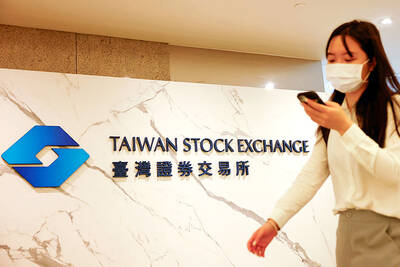The nation’s unemployment rate dropped to 3.79 percent last month, the lowest December figure in 16 years, as companies increased headcount amid continued economic recovery, the Directorate-General of Budget, Accounting and Statistics (DGBAS) said in a report yesterday.
The jobless rate might drop further this month and through the Lunar New Year holiday, ending in early next month when retailers and eateries, as well as lodging and entertainment facilities, tend to add temporary positions to meet increasing demand, the agency said.
The service industry hired 58,000 people last month, while the industrial and agricultural sectors added 8,000 and 2,000 employees respectively, the report showed.
This lowered the nation’s unemployed population by 9,000 people to 446,000 last month with the seasonally adjusted jobless rate falling by 0.02 percentage points to 3.82 percent, the report said.
For the entire last year, unemployment rate stood at 3.92 percent, 0.14 percentage points higher from a year earlier, translating into an increase of 20,000 jobless people, the report said.
DGBAS Deputy Director Pan Ning-hsin (潘寧馨) attributed the increase to an economic slowdown that stretched from the second half of 2015 until the first half of last year.
The nation has since emerged from the slowdown, thanks to improving external demand and stabilized crude oil prices, Pan said.
Unemployment remained high among young people with higher education last year, the report said.
The jobless rate was highest among people who have university degrees or higher at 4.84 percent, followed by people with college diplomas at 4.23 percent, it showed.
Unemployment stood at 3.9 percent for people with high-school diplomas and at 3.09 percent for people with at most a junior-high school education, it said.
The jobless rate was highest among people aged 15 to 24 at 12.12 percent, followed by the 25-to-29 age bracket at 6.76 percent, the agency said. Unemployment stood at 4.08 percent for people aged between 25 and 44 and at 2.15 percent for people aged between 45 and 64, it said.
Improved economic conditions enabled companies to increase wages, the agency said in a separate report.
Monthly take-home wages rose to NT$39,464 in November last year, up 1.62 percent from a year earlier, it said.
Including bonuses and other perks, the average monthly wage stood at NT$43,866, an increase of 3.13 percent from a year earlier, the report said.
In the first 11 months of last year, take-home wages rose 1.3 percent while the average salary rose 3.13 percent, it said.
However, both take-home and average wages declined 0.03 percent and 0.86 percent respectively after factoring in the rise in consumer prices, the agency said.

ADVANCED: Previously, Taiwanese chip companies were restricted from building overseas fabs with technology less than two generations behind domestic factories Taiwan Semiconductor Manufacturing Co (TSMC, 台積電), a major chip supplier to Nvidia Corp, would no longer be restricted from investing in next-generation 2-nanometer chip production in the US, the Ministry of Economic Affairs said yesterday. However, the ministry added that the world’s biggest contract chipmaker would not be making any reckless decisions, given the weight of its up to US$30 billion investment. To safeguard Taiwan’s chip technology advantages, the government has barred local chipmakers from making chips using more advanced technologies at their overseas factories, in China particularly. Chipmakers were previously only allowed to produce chips using less advanced technologies, specifically

BRAVE NEW WORLD: Nvidia believes that AI would fuel a new industrial revolution and would ‘do whatever we can’ to guide US AI policy, CEO Jensen Huang said Nvidia Corp cofounder and chief executive officer Jensen Huang (黃仁勳) on Tuesday said he is ready to meet US president-elect Donald Trump and offer his help to the incoming administration. “I’d be delighted to go see him and congratulate him, and do whatever we can to make this administration succeed,” Huang said in an interview with Bloomberg Television, adding that he has not been invited to visit Trump’s home base at Mar-a-Lago in Florida yet. As head of the world’s most valuable chipmaker, Huang has an opportunity to help steer the administration’s artificial intelligence (AI) policy at a moment of rapid change.

The New Taiwan dollar is on the verge of overtaking the yuan as Asia’s best carry-trade target given its lower risk of interest-rate and currency volatility. A strategy of borrowing the New Taiwan dollar to invest in higher-yielding alternatives has generated the second-highest return over the past month among Asian currencies behind the yuan, based on the Sharpe ratio that measures risk-adjusted relative returns. The New Taiwan dollar may soon replace its Chinese peer as the region’s favored carry trade tool, analysts say, citing Beijing’s efforts to support the yuan that can create wild swings in borrowing costs. In contrast,

TARIFF SURGE: The strong performance could be attributed to the growing artificial intelligence device market and mass orders ahead of potential US tariffs, analysts said The combined revenue of companies listed on the Taiwan Stock Exchange and the Taipei Exchange for the whole of last year totaled NT$44.66 trillion (US$1.35 trillion), up 12.8 percent year-on-year and hit a record high, data compiled by investment consulting firm CMoney showed on Saturday. The result came after listed firms reported a 23.92 percent annual increase in combined revenue for last month at NT$4.1 trillion, the second-highest for the month of December on record, and posted a 15.63 percent rise in combined revenue for the December quarter at NT$12.25 billion, the highest quarterly figure ever, the data showed. Analysts attributed the